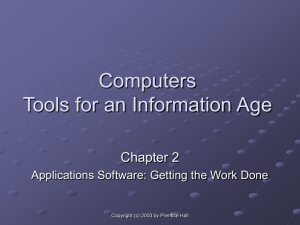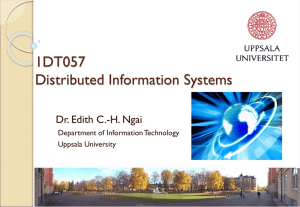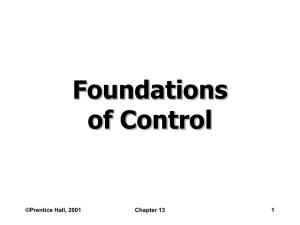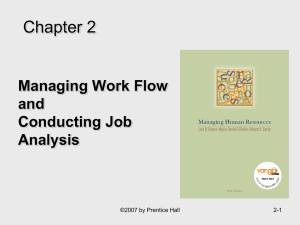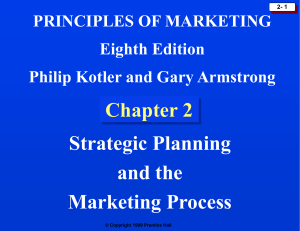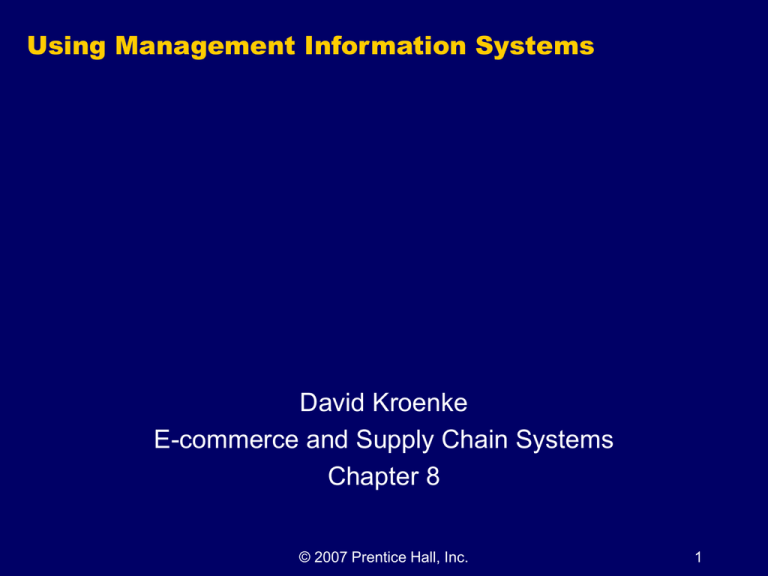
Using Management Information Systems
David Kroenke
E-commerce and Supply Chain Systems
Chapter 8
© 2007 Prentice Hall, Inc.
1
Learning Objectives
Understand Porters five competitive forces
model.
Define e-commerce and important e-commerce
terms.
Understand the effect of e-commerce on market
efficiency.
Learn technology for supporting commerce
servers.
© 2007 Prentice Hall, Inc.
2
Learning Objectives (Continued)
Understand the structure, profitability, and
dynamics of supply chains.
Know the purpose, concepts, advantages, and
disadvantages of EDI.
Know the purpose, concepts, advantages, and
disadvantages of XML.
© 2007 Prentice Hall, Inc.
3
Porter’s Five Competitive Forces Model
Porter developed a third model that helps to
introduce the notion of interorganizational systems
called the Porter’s five competitive forces
model.
According to this model, five competitive forces
determine profitability:
Bargaining power of suppliers
Bargaining power of customers
New entrants to the market
Rivalry among firms
Threats of substitutions for an organization’s products or
services
© 2007 Prentice Hall, Inc.
4
Porter’s Five Competitive Forces Model
(Continued)
These factors determine not only how
organizations gain competitive advantages, but
also how sustainable those advantages are.
For example, when an organization adds value to its
products and obtains an increase in price, it may not be
able to sustain that price.
Information systems play a key role in obtaining
sustainable advantages among organizations.
© 2007 Prentice Hall, Inc.
5
Figure 8-1 Porter’s Model of Industry Structure
Source: Adapted with the permission of The Free Press, a Division of Simon & Schuster Adult Publishing Group, from Competitive Advantage:
Creating and Sustaining Superior Performance by Michael E. Porter. Copyright © 1985, 1998 by Michael E. Porter. All rights reserved.
© 2007 Prentice Hall, Inc.
6
E-Commerce
E-commerce is the buying and selling of goods
and services over public and private computer
networks.
The U.S. Census Bureau, which publishes
statistics on e-commerce activity, defines
merchant companies as those that take title to
the goods they sell.
They buy goods and resell them.
© 2007 Prentice Hall, Inc.
7
E-Commerce (Continued)
The U.S. Census Bureau defines nonmerchant
companies as those that arrange for the purchase
and sale of goods without ever owning or taking
title to those goods.
© 2007 Prentice Hall, Inc.
8
Figure 8-2 E-Commerce Categories
© 2007 Prentice Hall, Inc.
9
E-Commerce Merchant Companies
There are two types of merchant companies:
those that sell directly to consumers and those
that sell to companies.
Each uses slightly different information systems in
the course of doing business.
B2C, or business-to-consumer, e-commerce
concerns sales between a supplier and a retail
customer (the consumer).
© 2007 Prentice Hall, Inc.
10
E-Commerce Merchant Companies (Continued)
A typical information system for B2C provides a
Web-based application or Web storefront by
which customers enter and manage their orders.
Amazon.com, REI.com, and LLBean.com are examples
of companies that use B2C information systems.
The term B2B, or business-to-business, ecommerce refers to sales between companies.
Raw materials suppliers use B2B systems to sell to
manufacturers, manufacturers use B2B to sell to
distributors, and distributors uses B2B systems to sell to
retailers.
© 2007 Prentice Hall, Inc.
11
E-Commerce Merchant Companies (Continued)
B2G, or business-to-government, refers to sales
between companies and government
organizations.
A manufacturer that uses an e-commerce site to
sell computer hardware to the U.S. Department of
State is engaging in B2G commerce.
Suppliers, distributors, and retailers can sell to the
government as well.
© 2007 Prentice Hall, Inc.
12
Figure 8-3 Example of Use of B2B, B2G, and B2C
© 2007 Prentice Hall, Inc.
13
Nonmerchant E-commerce
The most common nonmerchant e-commerce
companies are auctions and clearing houses.
E-commerce auctions match buyers and sellers
by using an e-commerce version of a standard
auction.
This e-commerce application enables the auction
company to offer goods for sale and to support a
competitive bidding process.
The best-known auction company is eBay, but many
other auction companies exist; many serve particular
industries.
© 2007 Prentice Hall, Inc.
14
Nonmerchant E-commerce (Continued)
Clearinghouses provide goods and services at a
stated price, and they arrange for the delivery of
the goods but they never take title.
As a clearinghouse, Amazon matches the seller
and the buyer and then takes payment from the
buyer and transfers the payment to the seller,
minus commission.
Other examples of clearinghouse are electronic
exchanges that match buyers and sellers; the
business process is similar to that of a stock
exchange.
© 2007 Prentice Hall, Inc.
15
Figure 8-4 Amazon Clearinghouse Sales
Source: © 2005 Amazon.com, Inc. All Rights Reserved.
© 2007 Prentice Hall, Inc.
16
E-Commerce Improves Market Efficiency
E-commerce leads to disintermediation, which is
the elimination of middle layers in the supply
chain.
You can buy a flat-screen LCD HDTV from a typical
electronic store or you can use e-commerce to buy it
from the manufacturer.
If you take the later route, you eliminate at least one
distributor, the retailer, and possibly more.
E-commerce also improves the flow of price
information.
As a consumer, you can go to any number of Web sites
that offer product price comparisons.
© 2007 Prentice Hall, Inc.
17
E-Commerce Improves Market Efficiency
(Continued)
E-commerce also improves the flow of price
information (continued)
The improved distribution of information about price and
terms enables you to pay the lowest possible cost and
serves ultimately to remove inefficient vendors.
The market as a whole becomes more efficient.
From the seller’s side, e-commerce produces
information about price elasticity that has not
been available before.
Price elasticity measures the amount that demand
rises or falls with changes in price.
© 2007 Prentice Hall, Inc.
18
E-Commerce Improves Market Efficiency
(Continued)
Using an auction, a company can learn not just
what the top price for an item is, but also learn the
second, third, and other prices from the losing
bids.
Managing prices by direct interaction with
customers yields better information than managing
prices by watching competitors’ pricing.
Many B2B and other interorganizational
information systems require meetings among the
companies involved to design the joint processes
that will be used and eventually to negotiate
contracts.
© 2007 Prentice Hall, Inc.
19
Figure 8-5 E-Commerce Market Consequences
© 2007 Prentice Hall, Inc.
20
E-Commerce Economics
Companies need to consider the following
economic factors:
Channel conflict
Price conflict
Logistics expense
Customer service expense
© 2007 Prentice Hall, Inc.
21
E-Commerce and the World Wide Web
Most B2C commerce conducted over the World
Wide Web (WWW) uses Web storefronts
supported by commerce servers.
A commerce server is a computer that operates
Web-based programs that display products,
support online ordering, record and process
payments, and interface with inventorymanagement applications.
© 2007 Prentice Hall, Inc.
22
Figure 8-6 Internet Protocols and Users
© 2007 Prentice Hall, Inc.
23
Web Pages and Hypertext Markup Language
HTTP is used to exchange Web pages over the
Internet.
Such pages are documents encoded in a language
called HTML, or Hypertext Markup Language.
This language defines the structure and layout of Web
pages.
An HTML tag is a notation used to define a data
element for display or other purposes.
Web pages include hyperlinks, which are pointers
to other Web pages.
A hyperlink contains the URL (Uniform Resource
Locator) of the Web page to obtain when the user clicks
the hyperlink.
© 2007 Prentice Hall, Inc.
24
Web Pages and Hypertext Markup Language
(Continued)
The two most popular Web server programs are
Apache, commonly used on Linux, and IIS
(Internet Information Server), a component of
Windows XP Professional and other Windows
products.
A browser is a program that processes the HTTP
protocol; receives, displays, and processes HTML
documents; and transmits responses.
Common browsers are Internet Explorer, Netscape
Navigator, and Mozilla’s FireFox.
© 2007 Prentice Hall, Inc.
25
Figure 8-7a Sample HTML Document
© 2007 Prentice Hall, Inc.
26
Figure 8-7b HTML Document on Page 236 in
Figure 8-7a, rendered using Internet Explorer
Source: Microsoft product screen shot reprinted with permission from Microsoft Corporation.
© 2007 Prentice Hall, Inc.
27
Three-Tier Architecture
Most commerce server applications use what is
called three-tier architecture.
The tiers refer to three different classes of
computers.
The user tier consists of computers that have
browsers that request and process Web pages.
The server tier consists of computers that run
Web servers and in the process generate Web
pages in response to requests from browsers.
© 2007 Prentice Hall, Inc.
28
Three-Tier Architecture (Continued)
Web servers also process application programs.
To ensure acceptable performance, commercial
Web sites usually are supported by several or
even many Web server computers.
A facility that runs multiple Web servers is
sometimes called a Web farm.
Work is distributed among computers in a Web farm so
as to minimize customer delays.
The coordination among multiple Web server computers
is a fantastic dance.
© 2007 Prentice Hall, Inc.
29
Three-Tier Architecture (Continued)
The third tier is the database tier.
The computers at this tier receives and processes
SQL requests to retrieve and store data.
© 2007 Prentice Hall, Inc.
30
Figure 8-8 Three-Tier Architecture
© 2007 Prentice Hall, Inc.
31
Figure 8-9a Sample of Commerce Server Pages:
Product-offer Page
Source: Used with permission of REI.
© 2007 Prentice Hall, Inc.
32
Figure 8-9b Shopping-Cart Page
Source: Used with permission of REI.
© 2007 Prentice Hall, Inc.
33
Supply Chain Management
A supply chain is a network of organizations and
facilities that transforms raw materials into
products delivered to customers.
Customers order from retailers, who in turn order
from distributors, who in turn order from
manufacturers, who in turn order from suppliers.
The supply chain also includes transportation
companies, warehouses, and inventories and
some means for transmitting messages and
information among the organizations involved.
© 2007 Prentice Hall, Inc.
34
Supply Chain Management (Continued)
Because of disintermediation, not every supply chain has
all of these organizations.
Dell, for example, sells directly to the customer.
Both the distributor and retailer organizations are
omitted from its supply chain.
In other supply chains, manufacturers sell directly to
retailers and omit the distribution level.
Chain implies that each organization is connected to just
one company up (toward the supplier) and down (toward
the customer) the chain.
Instead, at each level, an organization can work with
many organizations both up and down the supply chain.
Thus, a supply chain is a network.
© 2007 Prentice Hall, Inc.
35
Figure 8-10 Supply Chain Relationships
© 2007 Prentice Hall, Inc.
36
Figure 8-11 Supply Chain Example
© 2007 Prentice Hall, Inc.
37
Drivers of Supply Chain Performance
Four major factors, or drivers, affect supply chain
performance:
Facilities concern the location, size and operations
methodology of the places where products are
fabricated, assembled or stored.
Inventory includes all of the materials in the supply
chain, including raw materials, in-process work, and
finished goods.
Transportation concerns the movement of materials in
the supply chain.
Information influences supply chain performance by
affecting the ways that organizations in the supply chain
request, respond, and inform one another.
© 2007 Prentice Hall, Inc.
38
Figure 8-12 Drivers of Supply Chain Performance
© 2007 Prentice Hall, Inc.
39
Supply Chain Profitability Versus Organizational
Profitability
Supply chain profitability is the difference
between the sum of the revenue generated by the
supply chain and the sum of the costs that all
organizations in the supply chain incur and the
sum of the costs that all organizations in the
supply chain incur to obtain that revenue.
In general, the maximum profit to the supply chain
will not occur if each organization in the supply
chain maximizes its own profits in isolation.
© 2007 Prentice Hall, Inc.
40
Supply Chain Profitability Versus Organizational
Profitability (Continued)
Usually, the profitability of the supply chain
increases if one or more of the organizations
operates at less than its own maximum
profitability.
© 2007 Prentice Hall, Inc.
41
The Bullwhip Effect
The bullwhip effect is a phenomenon in which
the variability in the size and timing of orders
increase at each stage up the supply chain, from
customer to supplier.
The bullwhip effect is a natural dynamic that
occurs because of the multistage nature of the
supply chain.
It is not related to erratic consumer demand.
© 2007 Prentice Hall, Inc.
42
The Bullwhip Effect (Continued)
The large fluctuations of the bullwhip effect
distributors, manufacturers, and suppliers to carry
larger inventories than should be necessary to
meet the real consumer demand.
Thus, the bullwhip effect reduces the overall profitability
of the supply chain.
One way to eliminate the bullwhip effect is to give
all participants in the supply chain access to
consumer-demand information from the retailer.
© 2007 Prentice Hall, Inc.
43
The Bullwhip Effect (Continued)
Each organization can thus plan its inventory or
manufacturing based on true demand and not on
the observed demand from the next organization
up in the supply chain.
An interorganizational information system is necessary
to share such data.
Some SRM packages include features to support
procurement auctions.
Generally, companies use auctions to obtain large
amounts of materials, energy, or other
consumables.
© 2007 Prentice Hall, Inc.
44
The Bullwhip Effect (Continued)
In these procurement auctions, an organization
indicates its desire to purchase a product or
service and invites would-be sellers to submit bids.
Typically, the low bid wins the auction.
Organizational auctions can attract a large number
of vendors and often result in substantial cost
savings.
© 2007 Prentice Hall, Inc.
45
Figure 8-13 The Bullwhip Effect
© 2007 Prentice Hall, Inc.
46
Figure 8-14 B2B One Section of the Supply Chain
© 2007 Prentice Hall, Inc.
47
Supplier Relationship Management
Supplier relationship management (SRM) is a
business process for managing all contracts
between an organizational and its suppliers.
Supplier in SRM is used generically: It refers to
any organization that sells something to the
organization that has the SRM application.
A manufacturer is a supplier to a distributor.
© 2007 Prentice Hall, Inc.
48
Supplier Relationship Management (Continued)
SRM applications support three basic processes:
source, purchase, and settle.
Source
Organizations need to find possible vendors of needed
supplies, materials, or services:
Assess the vendors that it does find
Negotiate terms and conditions
Formalize those terms and conditions in a
procurement contract
Some SRM applications have features to search for
product sources and to find evaluations of vendors and
products.
© 2007 Prentice Hall, Inc.
49
Supplier Relationship Management (Continued)
Purchase
SRM applications request information, quotations, and
proposals from would-be suppliers.
Companies can use SRM to manage the approval
workflow in order to approve purchases and issue
orders.
Settle
The accounting department reconciles the receipt of the
goods and services against documents and schedules
the vendor payments.
The payment portion of the SRM typically connects to
the cash management subsystem in the financial
management application.
© 2007 Prentice Hall, Inc.
50
Supplier Relationship Management (Continued)
Settle (continued)
Some SRM packages include features to support
procurement auctions.
Generally companies use auctions to obtain large
amounts of materials, energy, or other consumables.
Organizational auctions can attract a large number of
vendors and often result in substantial cost savings.
© 2007 Prentice Hall, Inc.
51
Figure 8-15 Summary of SRM Processes
© 2007 Prentice Hall, Inc.
52
Integrating SRM with CRM
Supplier’s CRM application interfaces with the
purchaser’s SRM application.
Both the supplier and the customer want to
perform the ordering process as cheaply and
efficiently as possible.
SRM examines inventory, determines that items
are required, and automatically creates the order
via its connection to the supplier’s CRM.
© 2007 Prentice Hall, Inc.
53
Figure 8-16 ERP II in One Section of the Supply
Chain
© 2007 Prentice Hall, Inc.
54
Information Technology for Data Exchange
Web commerce-server applications are useful for
B2C, but they are not sufficient for B2B needs.
In general, organizations need to exchange data
and messages in more general and flexible ways
than they can do with commerce servers.
There are several alternatives for exchanging data
and messages (Basic Technology):
The most basic are telephone calls and documents
exchanged via fax or postal mail.
Another alternative is to exchange messages and
documents via email.
© 2007 Prentice Hall, Inc.
55
Information Technology for Data Exchange
(Continued)
There are alternatives that involve additional
technology
Electronic Data Interchange (EDI) is a standard for
exchanging documents from machine to machine,
electronically.
In the past, EDI was used over point-to-point or valueadded networks.
Recently, EDI systems have been developed that use
the Internet as well.
eXtensible Markup Language (XML), is a standard that
offers advantages over EDI and that most believe will
eventually replace EDI.
© 2007 Prentice Hall, Inc.
56
Figure 8-17 Alternatives for Inter organizational
Message and Data Exchange
© 2007 Prentice Hall, Inc.
57
Electronic Data Interchange
Electronic Data Interchange (EDI) is a standard
of formats for common business documents.
Because the transmissions are electronic, the
distributors and manufacturers must agree on a
format for the orders.
This format includes:
How many data fields will be sent.
In what order they will be sent.
How many characters will be sent in each data field,
and so forth.
© 2007 Prentice Hall, Inc.
58
The EDI X12 Standard
In the United States, the X12 Committee of the
American National Standards Institute (ANSI)
manages EDI standards.
Today, the EDI X12 standard includes hundreds of
documents.
They have standard names like EDI 850 (purchase
order), EDI 856 (advance ship notices), EDI 810
(electronic invoice).
AN EDI document definition consists of a set of
segments, each of which has a defined set of fields.
© 2007 Prentice Hall, Inc.
59
Figure 8-18 Portion of EDI 850 (Purchase Order)
Standard
© 2007 Prentice Hall, Inc.
60
Other EDI Standards
EDIFACT standard is used internationally.
HIPAA standard is used for medical records.
Because of the existence of multiple standards,
when two organizations today wish to exchange
documents electronically, they must first agree on
which standard they will use.
© 2007 Prentice Hall, Inc.
61
Other EDI Standards (Continued)
With usage, organizations find a need to make
adjustments to the standards.
There are various versions of each of the X12,
EDIFACT, and HIPAA standards.
© 2007 Prentice Hall, Inc.
62
eXtensible Markup Language
Organizations have used HTML to share
documents.
There are three problems with HTML:
HTML tags have no consistent meaning.
HTML has a fixed number of tags.
HTML mixes format, content, and structure.
© 2007 Prentice Hall, Inc.
63
Importance of XML
To overcome the problems in HTML, the computer
industry designed a new markup language called
the eXtensible Markup Language (XML).
XML is the product of a committee that worked
under the auspices of the World Wide Web
Consortium (W3C), a body that sponsors the
development and dissemination of Web standards.
XML provides a superior means for organizations to
exchange documents.
© 2007 Prentice Hall, Inc.
64
Importance of XML (Continued)
XML solves the problems mentioned for HTML, and
has become a significant standard for computer
processing.
© 2007 Prentice Hall, Inc.
65
Figure 8-19 XML Industry Standards
© 2007 Prentice Hall, Inc.
66
Application Interaction in the Supply Chain
The process of a program on one computer
accessing programs on a second computer is called
remote computing or distributed computing.
Several different techniques are used:
Two important ones are the use of proprietary designs and
Web services
© 2007 Prentice Hall, Inc.
67
Distributed Computing Using Proprietary Designs
One way to develop distributed computer programs
is to develop proprietary distributed applications.
Proprietary means that the solution is unique to and is
owned by the organizations that develop and pay for the
distributed systems.
To develop a proprietary design, teams of
developers from the involved companies work
together using a development process.
The joint development team designs this application
to use a particular communications capability,
particular operating systems, and particular
distributed computing techniques.
© 2007 Prentice Hall, Inc.
68
Distributed Computing Using Proprietary Designs
(Continued)
An alternative proprietary method is for one
company to develop all necessary programs itself
and then install some of its programs on another
company’s computers.
Proprietary solutions are difficult and expensive to
develop and operate.
If they provide sufficient business value, however,
the return on investment can make them worthwhile.
© 2007 Prentice Hall, Inc.
69
XML Web services
XML Web services, sometimes called simply Web
services, are a set of standards that facilitate
distributed computing using Internet technology.
Web services are the latest and greatest tool for
application interaction.
Every major software vendor has products that
support Web services:
Microsoft provides .Net development tools
IBM provides J2EE development tools
© 2007 Prentice Hall, Inc.
70
Fundamental Web Services Concepts
The goal of Web services is to provide a standard
way for programs to access one another remotely,
without the need to develop proprietary solutions.
A number of important standards have been defined
to make Web services possible.
In general these standards enable programs on one
computer to obtain a service description that details
what programs exist on another computer and how to
communicate with those programs.
Once the service user has the service description, it uses
the information it contains to invoke the service.
All Web service data are transmitted in XML documents.
© 2007 Prentice Hall, Inc.
71
Web Services and the Supply Chain
Web services have the potential to simplify the
automation of supply chain interactions.
Any organization in the supply chain can develop
Web services and publish those services to other
organizations in the supply chain.
Developers in those organizations can access the
service description and write programs that call the
Web services.
© 2007 Prentice Hall, Inc.
72
Figure 8-20 Example of Web Services for Sharing
Sales Data
© 2007 Prentice Hall, Inc.
73
Summary
Organizations should address four economic
factors when considering e-commerce activity:
channel conflict, price conflict, logistics expense,
and customer service expense.
Most B2C commerce is conducted using
commerce servers.
A supply chain is a network of organizations and
facilities that transforms raw materials into
finished goods for customers.
© 2007 Prentice Hall, Inc.
74
Summary (Continued)
Most supply chains have suppliers, manufactures,
distributors, and retailers.
Supply chains also include transportation
companies, warehouses, inventories, and some
means of transmitting messages and information.
In general, the maximum profits to the supply
chain will not occur if each independent
organization within it maximizes its own profit in
isolation.
© 2007 Prentice Hall, Inc.
75
Summary (Continued)
The bullwhip effect is a phenomenon in which the
variability in the size and timing of orders
increases at each stage up the supply chain.
Three fundamental supply chain information
systems are: supplier relationship management
(SRM), inventory, and CRM.
Organizations can exchange documents and data
between programs using various alternatives.
© 2007 Prentice Hall, Inc.
76
Summary (Continued)
EDI is a standard of formats for common business
documents.
XML is a markup language like HTML, but it
improves upon HTML by requiring standard use of
XML elements by allowing users to extend the
elements, and by clearly separating document
structure, content, and format.
© 2007 Prentice Hall, Inc.
77
Key Terms and Concepts
Attribute
Auctions
Browser
Bullwhip effect
Business-to-business (B2B)
e-commerce
Business-to-consumer (B2C)
e-commerce
Business-to-government
(B2G) e-commerce
Clearinghouses
Commerce server
Database tier
Disintermediation
Distributed computing
E-commerce
EDI X12 standard
EDIFACT standard
Electronic Data Interchange
(EDI)
eXtensible markup language
(XML)
HIPAA standard
Hyperlink
Hypertext Markup Language
(HTML)
© 2007 Prentice Hall, Inc.
78
Key Terms and Concepts (Continued)
Merchant companies
Nonmerchant companies
Porter’s five competitive
forces model
Price elasticity
Remote computing
Server tier
Service description
Supplier relationship
management (SRM)
Supply chain
Supply chain profitability
Sustainable (advantage)
Tag
Three-tier architecture
© 2007 Prentice Hall, Inc.
79
Problem Solving Guide–Interorganizational
Information Exchange
Interorganizational information systems are
systems that connect two or more organizations
and require collaborative agreements among
independent companies and organizations.
Such agreements can be successful only if all
parties have a clear idea of the goals, benefits,
costs, and risks of working together.
© 2007 Prentice Hall, Inc.
80
Problem Solving Guide–Interorganizational
Information Exchange (Continued)
The creation of collaborative agreements requires
many joint meetings in which the parties make their
goals and objectives clear and decide how best to
share information and other resources.
During your career, you may be asked to participate in
such meetings.
When you meet with employees of another
company, realize that you must apply stronger
limits on your conversation than when you meet
with employees in your own firm.
© 2007 Prentice Hall, Inc.
81
Problem Solving Guide–Interorganizational
Information Exchange (Continued)
You should assume that whatever you say to an
employee of another company could be general
knowledge in your industry the next day.
The best strategy, however, is to reveal exactly
what you must reveal and no more.
You may be asked to sign a nondisclosure
agreement.
© 2007 Prentice Hall, Inc.
82
Opposing Forces Guide–The Lawyer’s FullEmployment Act
I don’t think this supply chain profitability thing is
likely to work the way it’s described here.
It sounds like some head-in-the-cloud idea
dreamed up by economists.
“First of all, how many products does REI sell?”
Thousands. “And how many distributors does it
have?” Dozens. “How would the company ever
know that outages on boots were limiting sales of
ski packages?”
© 2007 Prentice Hall, Inc.
83
Opposing Forces Guide–The Lawyer’s FullEmployment Act (Continued)
Knowing that, REI decides to pay a premium to the
boot distributor to carry a larger-than-normal
inventory of boots.
First of all, you wonder why REI doesn’t just carry that
inventory itself.
But anyway, somehow it is going to make a payment to
the distributor to carry more boot inventory.
Now REI has to negotiate an agreement among at least
three companies, and probably more if you include the
manufacturers.
© 2007 Prentice Hall, Inc.
84
Opposing Forces Guide–The Lawyer’s FullEmployment Act (Continued)
“By the time you get all this done, it’s no longer ski
season, and you’re not selling any ski equipment”.
“By the time next year rolls around, you’re working
with different distributors”.
“It just’ won’t work”.
© 2007 Prentice Hall, Inc.
85
Ethics Guide–The Ethics of Supply Chain
Information Sharing
Suppose that you work for a distributor that has
developed information systems to read inventory
data both up and down the supply chain.
Situation A
You notice that the store inventories of all retailers are
running low on items in a particular product family.
Because you believe you have the only supply of those
items, you increase their price by 15 percent.
When the retailers ask why, you claim extra
transportation costs.
© 2007 Prentice Hall, Inc.
86
Ethics Guide–The Ethics of Supply Chain
Information Sharing (Continued)
Situation A (continued)
In fact, all of the increase is going straight to your
bottom line.
Situation B
Unknown to you, one of your competitors has also
accumulated a large inventory of those same items.
Your competitor does not increase prices on those
items, and consequently you sell none at your increased
price.
© 2007 Prentice Hall, Inc.
87
Ethics Guide–The Ethics of Supply Chain
Information Sharing (Continued)
Situation B (Continued)
You have no direct way to read your competitor’s
inventories, but you can infer their inventories by
watching the decrease of inventory levels on the
manufacturer side and comparing that decrease to the
sales on the retail side.
Using this process, you now can estimate your
competitor’s inventories.
Situation C
Assume the agreement you have with the retailers is
that you are able to query all of their current inventory
levels but only for the orders they have with you.
© 2007 Prentice Hall, Inc.
88
Ethics Guide–The Ethics of Supply Chain
Information Sharing (Continued)
Situation C (continued)
You are not supposed to be able to query orders they
have with your competitors.
However, the information system contains a flaw, and by
mistake you are able to query everyone’s orders-your
own as well as those of your competitors.
Situation D
Assume the same agreement with your retailers as in
situation C.
One of your developers, however, notices a hole in the
retailer’s security system and writes a program to exploit
that hole.
© 2007 Prentice Hall, Inc.
89
Ethics Guide–The Ethics of Supply Chain
Information Sharing (Continued)
Situation D (continued)
You now have access to all of the retailer’s sales,
inventory, and order data.
© 2007 Prentice Hall, Inc.
90
Security Guide–A Trojan Horse?
Suppose you work for a distributor that manages its
inventory very closely.
One of your major manufacturers says that it can
dramatically shorten the lead time on most of its
products if your purchasing personnel order directly
from the manufacturer's CRM.
To make that possible, the manufacturer needs to
install some of its programs on the computers in your
purchasing department.
© 2007 Prentice Hall, Inc.
91
Security Guide–A Trojan Horse? (Continued)
You agree to allow the installation.
The chief information officer (CIO) gets wind of this
project and refuses to allow the programs to be
installed on the computers in purchasing.
He also directs building security personnel not to allow
anyone from the manufacturer into your company’s
building.
The two of you have a meeting, and he is furious with you.
“Well” you counter, “I see your point and I’m sorry we didn’t
contact you sooner”.
“But what can we do now?”
“Using their system could mean huge cost savings to us”.
© 2007 Prentice Hall, Inc.
92
Reflection Guide–XML and the Future of
Computing
Once upon a time, computers were used solely for
computing.
They were valued for their ability to perform
arithmetic and complex calculations.
Today, few computers are valued primarily as
computational tools.
Today, they are valued because they
communicate.
© 2007 Prentice Hall, Inc.
93
Reflection Guide–XML and the Future of
Computing (Continued)
What’s the primary purpose of an IS in the supply
chain?
It is to communicate orders, invoices, or other
documents or send and receive data among programs.
Communications cannot occur without common
standards.
Computers must share standards to communicate.
Bill Gates called XML the “lingua franca of the Internet”.
A lingua franca is a common language widely used by
speakers of other languages.
© 2007 Prentice Hall, Inc.
94
Reflection Guide–XML and the Future of
Computing (Continued)
If XML is not yet the language of the Internet, it is
likely to be that within the next 5 years.
Today orders may arrive via postal mail, fax, as
attachments to emails, or through information
systems.
Regardless, without XML, everyone of those orders must
be manually validated.
A starting possible consequence of the growth of
XML on future computing relates to databases.
© 2007 Prentice Hall, Inc.
95
Reflection Guide–XML and the Future of
Computing (Continued)
Databases store tables not XML documents.
Why not store the XML documents in databases?
Before this can happen, significant problems must be
overcome:
How to efficiently query stores of XML documents
How to process duplicated data
How to make XML data available to table-oriented
programs like Excel
I’m willing to bet that by the end of your career,
relational databases will be the thing of the past.
It will be XML storage all the way!
© 2007 Prentice Hall, Inc.
96

